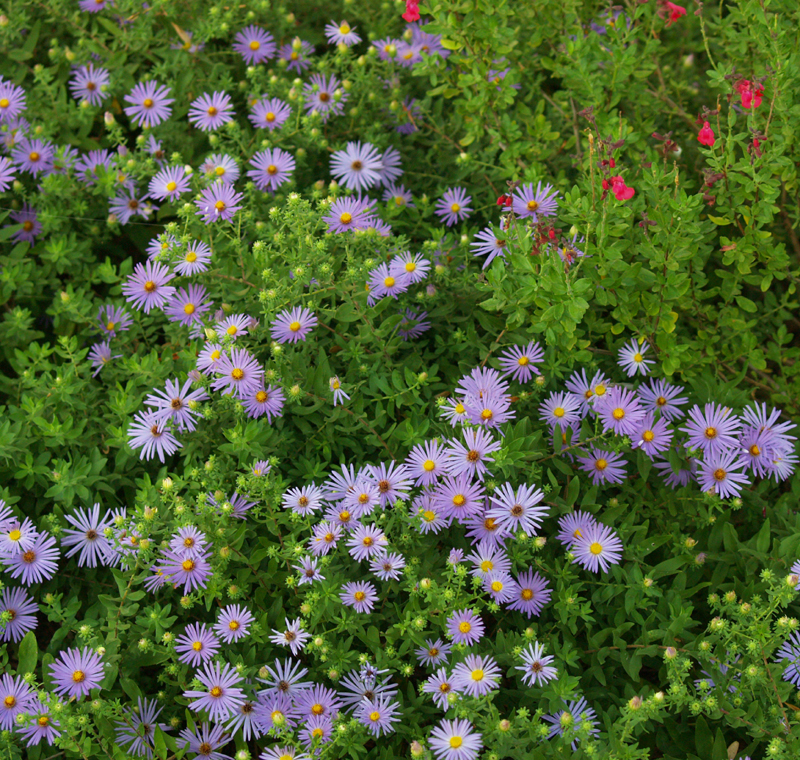February 3, 2011
No-freeze native plants + Mr. Smarty Plants unmasked!
If you can decide what to wear (shorts or parka, depending on what day it is), it’s a good time to cut back those dormant native plants. Tropicals, semi-tenders, and some evergreen shrubs should wait a few more weeks, especially since we got this good scare. But last weekend, I cut the asters to their rosettes and gave the Salvia greggiis a good topping. They won’t mind at all. The salvias will bloom soon on renewed growth (some already are) but it’ll be fall to get another scene like this.

I did leave the flowers on some salvias for the butterflies that were running around last weekend. But eventually, I must take the pruners to these plants before they get too leggy and lanky. Not only will they look better, they’ll get even more flowers!
Cut back your Tecoma stans (esperanza, yellow bells) to the ground. Do keep them mulched, especially if they’re young. If they’re not in enough sun (as mine are not any longer), move them after the last freeze date to get luscious summer flowers.

One chore this weekend is to chop the vacant woody stems of my firebush (Hamelia patens) to the ground. I wish I could have another picture like this with Salvia leucantha.

That area now gets too much shade, and the leucantha gave up. The firebush hasn’t whimpered, but it certainly doesn’t flower like it did in sunnier days.
I’ll also be cutting down turks cap, but it’s only a few months to this.

A couple of years ago, Andrea DeLong-Amaya from the Lady Bird Johnson Wildflower Center gave me a great tip: Underplant turks cap with spiderworts (Tradescantia gigantea).

Since I have about a gazillion spiderworts that pop up from seed, I move a few each fall as they emerge. This weekend I’ll move some more. Even transplanting this late has never disturbed their blooming for me. Now, I’ve got foliar fun and flowers to fill in those “holes” while the turks cap waits for warmer days to take over.
I still need to “detail prune” this zexmenia (Wedelia texana) where bulbs are coming up under its blankness. I’ve also planted spiderworts under some of them and nearby.

Here’s zexmenia in fall with chocolate flower (Berlandiera lyrata). On the evergreen chocolate flower, I simply pruned back its withered foliage.

If you love warm-loving Salvia coccinea, no need to cut it back.

Dig it up, since it’s a goner. But all is not lost, because they pop seeds like crazy to guarantee their return in a few months. After the last freeze, simply move your new free plants if their design decision doesn’t match yours.
I’m no expert on any of this, but I know where to go when I need answers: Mr. Smarty Plants, an online resource of the Lady Bird Johnson Wildflower Center. So, this week on CTG, Tom pulls the mask off Mr. Smarty Plants, Barbara Medford! Actually, she’s part of a fabulous team who answers questions from across the country to put you in touch with the native plants for your situation. Barbara’s knowledge, spicy wit, and personal dedication to set gardeners on the right path is a fabulous resource! You will love meeting her.
You can also hear Barbara and other Wildflower Center experts on Tom’s The Wildflower Hour on KLBJ-AM.
I know that Barbara would approve my White Avens (Geum canadense) that covers the ground in my shady beds, with these late spring flowers. I nabbed them a few years ago at one of the Wildflower Center’s plant sales.

I adore my golden groundsel (Packera obovata), also nabbed from the Wildflower Center sale, that will be blooming soon between flagstones.

Rosettes of pink evening primrose are about to explode. They arrived on their own.

This week, Daphne answers the question: why are there not so many weeds in the lawn/garden this winter? Well, it’s because we had cooler temps last summer and more rain last spring that encouraged our lawns and plants to flush out, shading the seed bank underground. Another factor is that we didn’t get rain last fall. In fact, that’s one reason why you’ll see fewer wildflowers this year than last. Seeds popped out with September’s rains, but then withered and died with drought and heat.
But, Sweetpea Hoover identifies some of the weeds that have cropped up, or will be arriving soon after our brief stint with rain!

All are beneficial in their own ways, but if you don’t want them, the best remedy is you-know-what: the trowel. If we miss them with that, be sure to nab them before they set seed. And think about this: unwanted weed, valued Salvia coccinea, or what we consider wildflowers? It’s the same principle: they don’t have our vocabulary for “weed” vs. “plant you buy.”
Actually, I keep some “weeds” this time of year, including that flowering henbit to feed insects. Butterflies were dipping into my dandelion flowers last weekend. When something fuels wildlife in these cold days, it gets a place in my garden, like my Oxalis drummondii.

To learn more about the ecology of wildflowers, along with their legends and lore, tune into KLRU on March 10 at 7 p.m. for Wildflowers|Seeds of History (other PBS stations to air in April, so check your listings). I’m in the final stages of post-production for this high definition documentary jam-packed with insight that promises you a new look at the back roads of history that forecast the seeds of the future.
Back to CTG’s garden tour this week, see how John Wilson and Debra Leff are making history with a front yard renovation that kaboshed the lawn for native plants, a courtyard pond, and a living room design that invites both neighbors and wildlife to drop in for a chat.
Until next week, Linda

